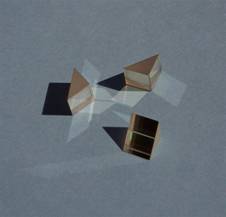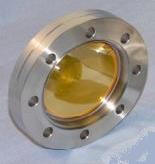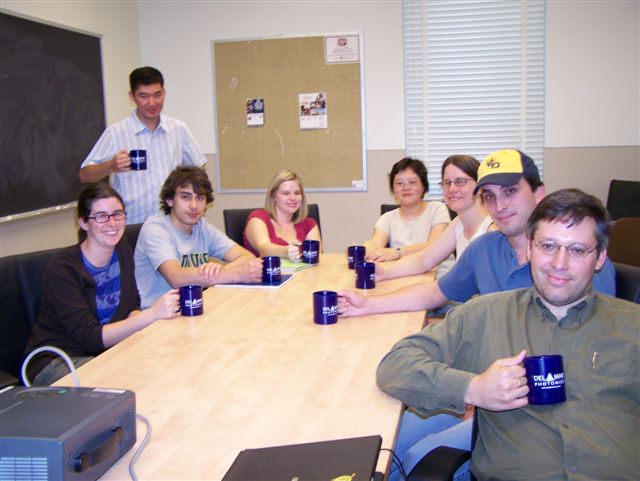
Del Mar Photonics - Newsletter December 2010 - Newsletter April 2011
CW Ti:Sapphire laser used in intracavity laser absorption spectroscopy request a quote
James J. O'Brien
Dr. O'Brien received his B.Sc. (Hons) from James Cook University, and his Ph.D.
degree from the Australian National University. He joined UM-St. Louis after
postdoctoral positions at the University of California-Berkeley, the National
Research Council of Canada, and the University of Arizona.
Research Interests
Jim O’Brien is an experimental physical chemist who specializes in fundamental
and applied, high-resolution laser spectroscopy and gas phase analytical
chemistry. The primary tool employed is Intracavity Laser Spectroscopy. ILS
techniques provide tremendously enhanced sensitivity for obtaining quantitative
absorption spectra. Research areas include: (1) the acquisition of quantitative
absorption spectroscopy parameters (e.g., absorption coefficients for methane in
the visible to near-IR spectral region to assist in interpreting spectra of the
outer planets such as Neptune and line positions for the high-resolution
spectrum of molecular O2 for visible and near-IR bands; (2) high-resolution
electronic spectroscopy of small molecules (e.g., CuCl, NiCl, NiH) with a view
to locating excited electronic states in these species; (3) the gas phase
chemistries and species involved in a variety of chemical vapor deposition (CVD)
processes (e.g., the plasma deposition of films of diamond-like carbon (DLC),
diamond-like nanocomposites (DLN), and silicon oxide); and (4) the further
development of the intracavity laser spectroscopy (ILS) technique for analytical
purposes (e.g., in acquiring spectra at ultra-high spectral resolution) and its
range of applications (e.g., extension of ILS into the IR region by use of fiber
lasers).
ILS system used for the methane studies conducted at sample temperature of 77 K.
Spectrum derived from high-resolution ILS measurements on methane at 2 to 30
torr.
ILS spectrum for the atmospheric A-band of O2. The spectrum in the left panel is
normalized to 3 torr and that in the right panel is normalized to 30 torr. Many
of the lines in the right panel spectrum are saturated but many more lines in
the band can be observed under these conditions.
Selected Publications
"Intracavity laser absorption spectroscopy of platinum sulfide in the near
infrared", K. Handler, L. C. O'Brien and J. J. O'Brien, J. Mol. Spectrosc. 2010,
263, 78.
"Spectroscopy of NiF by intracavity laser spectroscopy: Identification and
analysis of the (1,0) band of the [11.1] 2P3/2-X 2P3/2 electronic transition",
R. A. Harris, L. C. O'Brien and J. J. O'Brien, J. Mol. Spectrosc. 2010, 259,
116.
"Sb2S3:C/CdS p-n junction by laser irradiation", A. Arato, E. Cardenas, S.
Shaji, J. J. O'Brien, J. Liu, A. G..Castillo, T. K. Das Roy and B. Krishnan,
Thin Solid Films 2009, 517, 2493.
"Laboratory measurements of the (2,0) B2D5/2-X2D5/2 transition of nickel hydride
using intracavity laser absorption spectroscopy", S. Shaji, A. Song, M. Li, J.
J. O'Brien and L. C. O'Brien, Can. J. Phys. 2009, 87, 583
"Spectroscopy of PtO by intra-cavity laser spectroscopy: Identification of the
A30+ -x1 electronic transition", H. Liu, L. C. O'Brien, S. Shaji and J. J.
O'Brien, J. Mol. Spectrosc. 2009, 253, 73.
"Intracavity laser absorption spectroscopy of AuO. Identification of the B 2S
--X 2P3/2 transition", L. C. O'Brien, B. A. Borchert, A. Farquhar, S. Shaji, J.
J. O'Brien, J. Mol. Spectrosc. 2008, 252, 136-142.
"Intracavity laser absorption spectra of nickel hydride", S. Shaji, J. Nunn, J.
J. O'Brien, L. C. O'Brien, Astrophysical Journal, 2008, 672, 722
"Intracavity laser absorption spectroscopy of AuO: Identification of the b
4P3/2-X 2P3/2 transition" , S. Shaji, A. Song, J. J. O'Brien, B. A. Borchert and
L. C. O'Brien, J. Mol. Spectrosc. 2007, 243, 37.
"Fourier transform spectroscopy of NiCl. Identification of the [10.3] 4F7/2
state", K. D. Gibbs, D. J. Trader, L. C. O'Brien and J. J. O'Brien, J. Mol.
Spectrosc., 2006, 240 , 64.
"Spectroscopy of nickel chloride: Identification of the [15.0] 2P3/2 and [15.0]
2D5/2 states", J. W-H. Leung, J. Ye, A. S-C. Cheung, K. D. Gibbs, D. L. Palmer,
L. C. O'Brien and J. J. O'Brien, J. Mol. Spectrosc., 2006, 238, 42.
"Spectroscopy of NiCl: Identification of the X2P1/2 state", C. A. Rice, Corey T.
L. Kellerman, B. Owen, L. C. O'Brien, H. Cao and J. J. O'Brien, J. Mol.
Spectrosc., 2006, 235, 271.
"Laboratory measurements of NiH by intracavity laser absorption spectroscopy",
L. C. O'Brien and J. J. O'Brien, Astrophys. Journal, 2005, 621, 554.
"Spectroscopy of AuO: Identification of the [10.7] P 3/2 to X2P3/2 Transition",
L. C. O'Brien, S. C. Hardimon and J. J. O'Brien, J. Phys. Chem. A, 2004, 108,
11302.
"Fourier transform spectroscopy of NiCl: identification of a [9.1] W = 3/2
state", S. Tumturk, L. C. O'Brien and J. J. O'Brien, J. Mol. Spectrosc., 2004,
225, 225.
"Absorption spectra and absorption coefficients for methane in the 750-940 nm
region obtained by intracavity laser spectroscopy", J. J. O'Brien and H. Cao,
Journal of Quantitative Spectroscopy and Radiative Transfer, 2002, 75, 323.
Trestles LH
femtosecond lasers with integrated DPSS DMPLH laser pump -
DPSS DMPLH lasers

Del Mar Photonics - Newsletter December 2010 - Newsletter April 2011
Del Mar Photonics featured optical components
Del Mar Photonics continuously expands its optical components portfolio. Browse our online store, read monthly notes about our featured optical products or just send us your requirements or product ideas.
|
|
Axicon Lens Axicon lens also known as conical lens or rotationally symmetric prism is widely used in different scientific research and application. Axicon can be used to convert a parallel laser beam into a ring, to create a non diffractive Bessel beam or to focus a parallel beam into long focus depth. Del Mar Photonics supplies axicons with cone angles range from 130° to 179.5° for use with virtually any laser radiation. We manufacture and supply axicons made from BK7 glass, fused silica and other materials. buy online - download brochure |
 |
Rutile (TiO2) coupling
prisms Del Mar Photonics offers optical elements made of high quality synthetically grown Rutile Titanium Dioxide crystals. Rutile’s strong birefringency, wide transmission range and good mechanical properties make it suitable for fabrication of polarizing cubes, prisms and optical isolators. Boules having high optical transmission and homogeneity are grown by proprietary method. Typical boules have 10 - 15 mm in dia. and up to 25 mm length. Optical elements sizes - from 2 x 2 x 1 mm to 12.7 x 12.7 x 12.7 mm. Laser grade polish quality is available for finished elements. So far we the largest elements that we manufactured are 12 x15 x 5 mm, in which optical axis is parallel to 15 mm edge, 5 mm is along beam path, 12 x 15 mm faces polished 20/10 S/D, one wave flatness, parallelism < 3 arc.min. (better specs. available on request). more details - buy online - download brochure |
 |
Vacuum viewport Del Mar Photonics offer a range of competitively priced UHV viewports , Conflat, ISO or KF including a variety of coatings to enhance performance. Del Mar Photonics viewports are manufactured using advanced techniques for control of special and critical processes, including 100 percent helium leak testing and x-ray measurements for metallization control. Windows Materials include: Fused silica, Quartz , Sapphire , MgF2, BaF2, CaF2, ZnSe, ZnS, Ge, Si, Pyrex. Standard Viewing diameters from .55" to 1.94 ". Coating - a range of custom coatings can applied - which include - Single QWOT - Broad Band AR - V coatings - ITO - DLC (Diamond like coating) more details - request a quote |
 |
Manufacturing challenging optical components Our group works to characterize the interaction of biomolecules with solid surfaces, writes Dennis Hore of University of Victoria, Canada. Nature designs proteins with well-defined structures in solution. The conformation of these molecules may serve a structural purpose, or a chemical one in the case of enzymes. In order to further the progress of technologies that immobilize such molecules on synthetic surfaces (like biosensors employing enzymes), it is important to have a detailed understanding and control of the interactions of these molecules with the surface more For that project Del Mar has been able to manufacture all shapes of prisms from CaF2, fused silica, and ZnSe according to our custom specifications. Del Mar Photonics online store features windows, prisms, lenses, attenuators, etalons, crystals and wafers, and other items. Axicons, barium fluoride windows, germanium etalons, rutile (TiO2) prisms, microchannel plates and detectors, saturable absorber mirrors, photoconductive THz antennas, lithium niobate wafers and crystals and many other high quality affordable components for scientific research and OEM production are delivered globally from stock. Micro Prism from Del Mar Photonics - Concentrating Photovoltaics |
 |
We are looking forward to hear from you and help you with your optical and crystal components requirements. Need time to think about it? Drop us a line and we'll send you beautiful Del Mar Photonics mug (or two) so you can have a tea party with your colleagues and discuss your potential needs |
Trestles LH femtosecond lasers with integrated DPSS DMPLH laser pump - DPSS DMPLH lasers